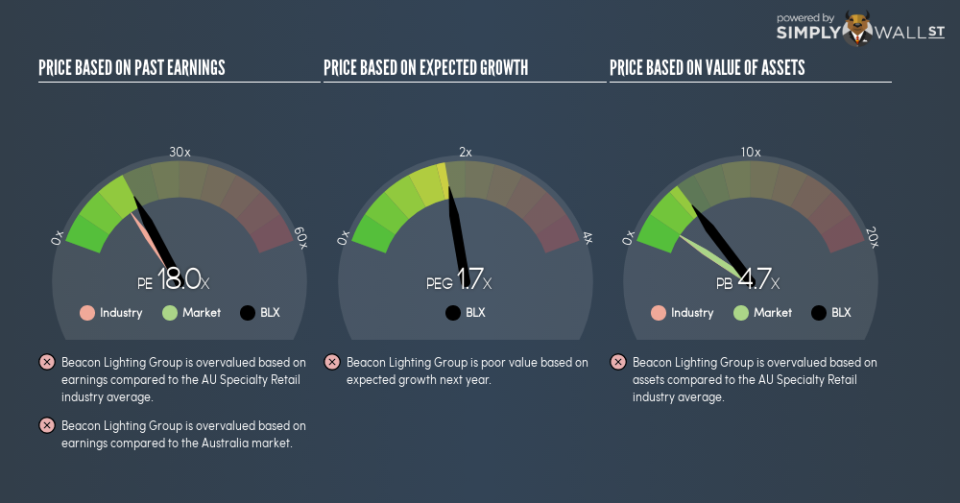Should You Be Tempted To Sell Beacon Lighting Group Limited (ASX:BLX) Because Of Its PE Ratio?

I am writing today to help inform people who are new to the stock market and want to learn about the link between company’s fundamentals and stock market performance.
Beacon Lighting Group Limited (ASX:BLX) is currently trading at a trailing P/E of 18x, which is higher than the industry average of 15x. While this makes BLX appear like a stock to avoid or sell if you own it, you might change your mind after I explain the assumptions behind the P/E ratio. In this article, I will explain what the P/E ratio is as well as what you should look out for when using it.
See our latest analysis for Beacon Lighting Group
Demystifying the P/E ratio
The P/E ratio is a popular ratio used in relative valuation since earnings power is a key driver of investment value. It compares a stock’s price per share to the stock’s earnings per share. A more intuitive way of understanding the P/E ratio is to think of it as how much investors are paying for each dollar of the company’s earnings.
P/E Calculation for BLX
Price-Earnings Ratio = Price per share ÷ Earnings per share
BLX Price-Earnings Ratio = A$1.55 ÷ A$0.0859 = 18x
On its own, the P/E ratio doesn’t tell you much; however, it becomes extremely useful when you compare it with other similar companies. We preferably want to compare the stock’s P/E ratio to the average of companies that have similar features to BLX, such as capital structure and profitability. A common peer group is companies that exist in the same industry, which is what I use. At 18x, BLX’s P/E is higher than its industry peers (15x). This implies that investors are overvaluing each dollar of BLX’s earnings. This multiple is a median of profitable companies of 24 Specialty Retail companies in AU including Story-I, Vita Group and Shaver Shop Group. Therefore, according to this analysis, BLX is an over-priced stock.
A few caveats
Before you jump to the conclusion that BLX should be banished from your portfolio, it is important to realise that our conclusion rests on two assertions. The first is that our “similar companies” are actually similar to BLX, or else the difference in P/E might be a result of other factors. For example, if you compared lower risk firms with BLX, then investors would naturally value it at a lower price since it is a riskier investment. The second assumption that must hold true is that the stocks we are comparing BLX to are fairly valued by the market. If this does not hold true, BLX’s lower P/E ratio may be because firms in our peer group are overvalued by the market.
What this means for you:
Since you may have already conducted your due diligence on BLX, the overvaluation of the stock may mean it is a good time to reduce your current holdings. But at the end of the day, keep in mind that relative valuation relies heavily on critical assumptions I’ve outlined above. Remember that basing your investment decision off one metric alone is certainly not sufficient. There are many things I have not taken into account in this article and the PE ratio is very one-dimensional. If you have not done so already, I highly recommend you to complete your research by taking a look at the following:
Future Outlook: What are well-informed industry analysts predicting for BLX’s future growth? Take a look at our free research report of analyst consensus for BLX’s outlook.
Past Track Record: Has BLX been consistently performing well irrespective of the ups and downs in the market? Go into more detail in the past performance analysis and take a look at the free visual representations of BLX’s historicals for more clarity.
Other High-Performing Stocks: Are there other stocks that provide better prospects with proven track records? Explore our free list of these great stocks here.
To help readers see past the short term volatility of the financial market, we aim to bring you a long-term focused research analysis purely driven by fundamental data. Note that our analysis does not factor in the latest price-sensitive company announcements.
The author is an independent contributor and at the time of publication had no position in the stocks mentioned. For errors that warrant correction please contact the editor at editorial-team@simplywallst.com.

 Yahoo Finance
Yahoo Finance 
